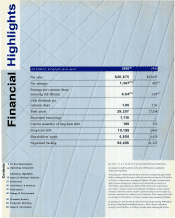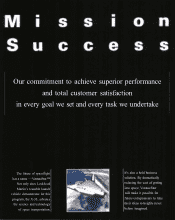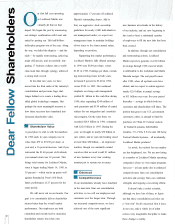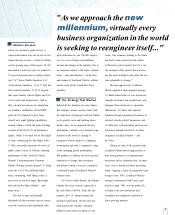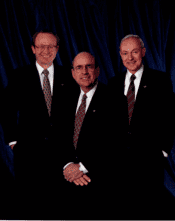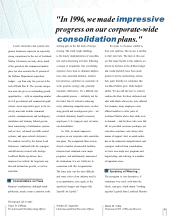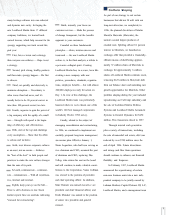Lockheed Martin 1996 Annual Report Download - page 10
Download and view the complete annual report
Please find page 10 of the 1996 Lockheed Martin annual report below. You can navigate through the pages in the report by either clicking on the pages listed below, or by using the keyword search tool below to find specific information within the annual report.
led by Frank C. Lanza, executive vice
president of Lockheed Martin. The
business units have nearly 4,900 employ-
ees and combined 1996 annual revenues
exceeding $650 million. At closing (which
remains subject to a number of contingen-
cies), the transaction is expected to
generate in excess of $400 million in cash
proceeds (net of taxes), allowing the
Corporation to continue its good progress
in reducing debt. The Corporation's reten-
tion of a partial interest in this joint
venture provides an opportunity to
continue building additional shareholder
value while at the same time concentrating
on our core businesses. In conjunction
with this transaction, we realigned the
businesses that formerly comprised
the C3I & Systems Integration Sector
among the Corporation's Electronics and
Information & Services Sectors.
Growth Markets
We are accelerating our entry into closely
related non-defense markets — very delib-
erately, though, as we are determined to
defy the old pattern of aerospace industry
diversification, which was in retrospect
largely unblemished by success. Just a few
examples give an idea of this opportunity-
rich strategy: We have entered the fast-
growing information services outsourcing
field, and Fieldcrest Cannon last year
chose us to provide those services; we are
developing, jointly with Intel Corporation,
a 3-D chip that will render richer, more
life-like graphics for PC users; we are pro-
viding wireless communications compo-
nents for a new Personal Communications
Services network, allowing that network
to use the existing cable infrastructure;
and last year we began to install our
E-ZPass electronic toll service on six
bridges and tunnels connecting New York
and New Jersey, just one of many state
and local services programs.
Lockheed Martin has successfully
applied its defense and aerospace tech-
nologies to new commercial products and
services including medical imaging and
filmless X-rays; fingerprint recognition
technology for the FBI; and graphics
boards for Sega's popular arcade games.
We are using our technology expertise
to develop large commercial and civil
infrastructure projects from full turnkey
telecommunications systems and
space imaging to implementing the
nation's largest privatized child support
payment system.
Our international business — espe-
cially defense, space, electronics, systems
integration, information and services — is
also important and growing. Today,
Lockheed Martin's international business
represents about 18 percent of total sales,
and we expect it to grow significantly over
the next several years. Toward that end,
we are actively pursuing strategic alliances
with partners on every continent to pool
resources, spread risks, enhance market
opportunities and apply diverse technology
solutions. Examples of this strategy
include a partnership with Russian industry
to jointly market the Atlas and Proton
launch vehicles, and a consortium of Asian
companies to develop regional mobile
telecommunications services, as well as
many other international companies with
whom we are teamed on major programs.
A Few Clouds
As successful as 1996 was, a company of
our size and breadth seemingly always
suffers some disappointments. In our case,
these included losing the maritime
patrol aircraft competition in the United
Kingdom; failing thus far to achieve
an intercept in developmental tests of
the Theater High Altitude Area Defense
(THAAD) system; and losing our initial
DarkStar unmanned aerial reconnaissance
vehicle during its second test flight. Our
contract with the Department of Energy to
remediate contaminated waste at the Pit 9
facility in Idaho still faces significant
schedule, technical and cost issues.
The good news is that in each of these
cases, we learned valuable lessons from the
global marketplace to the desolate reaches
of the White Sands Missile Test Range,
and we are marshalling our resources to
remedy the underlying problems.
Looking Ahead
With all that has been accomplished in the
past year, it is no time to be complacent:
On January 1, 1997, the register of accom-
plishment went back to zero, and while
Lockheed Martin has surged forward in
the race to consolidate, integrate, diversify
and build shareholder value, we are con-
stantly challenged by formidable competi-
tors, both in the U.S. and abroad.


